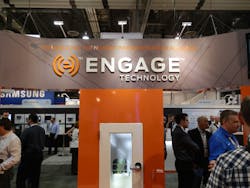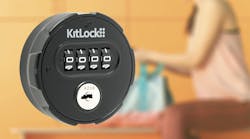While the pace of innovation in access control may seem relatively slow when compared to video surveillance, there have certainly been a number of technology developments in recent years that could have a significant impact on the market moving forward. Whether it is the advent of wireless locks or IP-based card readers, access control companies are constantly evolving to meet the demands of customers across a wide range of vertical markets.
The products on display at this year’s ISC West conference represented a microcosm of some of these broader trends taking place in the industry. A few years ago, the prospects surrounding near field communications (NFC) and the ability to use a smartphone as a credential were the talk of the industry and while mobile access still figures to play a role in the market, the hype surrounding the technology has somewhat waned. Instead, manufacturers have opted to focus on a variety of different technologies to help make the user’s experience with the access system more seamless than ever.
Here’s what several industry experts had to say about the biggest trends they see impacting the market, as well as some of the factors that are driving them:
Mitchell Kane, president, Vanderbilt Industries: I think one of the biggest trends now in the enterprise market is the expansion of access control throughout an enterprise. In the past, access control was often restricted to the perimeter of the building and sometimes extended to a network closet or datacenter. Now, we see enterprise organizations invest significantly in enterprise access control to protect their entire business, and that is a step in the right direction.
We’ve also seen a significant change in the use of offline locks, which have traditionally been specified for higher education or residence hall applications. Until recent advancements, offline locks were not ideal for enterprise-class commercial applications. The form factor and aesthetic are more industrial as they were designed for repeated use in hostile environments. In a corporate setting, significant emphasis is placed on the aesthetics of the atmosphere where it is unacceptable to install an industrial-looking device in a highly decorated space. Today, offline locks and wireless technology are being adapted into more approachable designs and form factors, ideal for interior doors. This trend goes along with the first trend I mentioned, that enterprises are extending access control from the perimeter and into the facility. We as product manufacturers have to provide solutions that enable this progression.
Another trend in today’s market is the evolution from plastic credential to mobile credentials — whether it’s a mobile phone or some sort of token. There’s a tremendous amount of opportunity in using an active device that delivers multiple purposes for access control but this effort is still in its infancy.
Karen Keating, portfolio marketing manager, electronics, Allegion: I think people are really starting to consider wireless solutions more and more frequently. By enabling (access) through wireless technology, they are seeing the value in that. Certainly, people are coming in and asking, ‘do you have an IP-based solution?’ So, I think the IP-based solutions are really kind of where the future of the industry is. We’re looking at it from the standpoint of the bigger picture. When you look at where the whole world is going with the Internet of Things, the fact that by the year 2020, 26 billion devices out there will be connected to Internet – well what does that mean? When you think about the worldwide population, it means multiple devices per person on this planet. How do you account for all of that? Well, it’s all about openings - the devices that you carry in your hand - and it’s about so many things. When we look at that, we have to be able to be on the forefront of technology in order to deliver what we know is coming in the future which is basically every door should be connected through the Internet of Things and you should be able to address that from the standpoint of a mobile application from anywhere in the world and make what you want to have happen at that door happen.
Robert Laughlin, president, Galaxy Control Systems: One of the things I see is that access control is more basic to the project. In other words, it is considered right at the beginning when it is still in the design stages rather than, ‘let’s build the building and then let’s think about adding access control later.’ Another big trend is schools which are really starting to get some money now and want to install systems to do lockdowns and what not on the classrooms which they didn’t have the money to do in the past. Now, all of sudden, they have money and we’ve gotten some very large orders from school systems. It’s not any one thing, there’s growth everywhere. Our government business is up, our commercial business is up, schools are up, hospitals are up, overseas orders are up… I mean all of these different business segments are up. Also, the integration between access control and the NVR system and other building systems is becoming more and more common.
Frank Gasztonyi, founder and CEO, Mercury Security Corporation: We are seeing the reinvention of the intelligent door control module. Looking back in the early 80s when I first got into this industry, we had intelligent access control panels… and they were all configured from a host system, contained a database and they were all typically located in close proximity to the door. They operated independently and they would all tie back to a single host computer. We have the same model reappearing today and because the communication link is faster, the memory capacity is larger and the host computer can run more of them, the premises being promoted is that architecture is now going to be fully scalable and appropriate for large-scale access control applications.
Unfortunately, this trend, even though it has been rediscovered with new enhanced capabilities, is not going to be appropriate for large scale systems. As the pendulum swings, I think the appropriate system architecture of having regional control properly distributed functionality is and will remain a necessity for larger system deployments to be effective. I think the industry gets excited about new products. Sometimes the new products have a set of expectations that are brought to the market and then as those new trends are being deployed; we’re finding their limitations, appropriate scale and appropriate applications. Then things get scaled back and we move along happily ever after again.”
Scott Lindley, president, Farpointe Data: As a long-term trend, one that I see and that we continue to exploit is the OEM manufacturing of credentials. In fact, if you take a look at one of the things we’re promoting here with our credentials is just how easy it is to private label. If you want to put your logo directly onto a credential, we can laser it into the card at the time of programming and marking. It adds very little cost and very little time to the order. Some people like to put a URL or a website on a credential, sometimes their corporate name or maybe even a symbol indicating what level card it is versus another card.
Long range is another trend that has emerged in the last year or two. We introduced our long range products about three years ago on the market. We showed it to everybody, talked it up like it was the greatest thing since sliced bread and the feedback came back, ‘meh.’ I can say last year the feedback improved some, but this year I’ve got to say that literally every third person that comes by says, ‘do you have a solution for me at long range?’
Jason Williams, general manager, Yale Residential: There are many trends that we are talking about here from an access control perspective. I think with all of the wireless locks, our ability to drive into new markets (has increased) but you’ve also got some of the other technologies that we’re showing here around energy-efficient solutions. We have been making a big deal about (IP locks) over the last three or four years and they have been well adopted now, so we’re focusing on some of the newer technologies at this point that are specific to some of these different vertical markets.
Kim Humborstad, CEO, Zwipe: More and more, organizations want to have biometric authentication at their higher security access points but do not want to pull out their present card readers at those points to add biometric readers plus face the prospective integration problems that they could face. Without having to change out their existing card readers, the Zwipe Access biometric card provides an easy, low cost way for organizations to provide a biometric upgrade to access control systems using legacy proximity card or smart card readers. With HID, Allegion and Farpointe all blessing the Zwipe access card, organizations using readers from these companies are now feeling confident in the use of such this simple, economical solution. Working with proximity and smart card readers now lets more end users use biometrics on high security openings, such as at a hospital pharmacy, IT server room or special research lab. Being acknowledged by the SIA judging panel at ISC West as the top product for user authentication, identification, credentialing and management is yet another indication of both the industry’s acceptance of biometrics as well as an endorsement of our product’s unique value proposition in the market.


